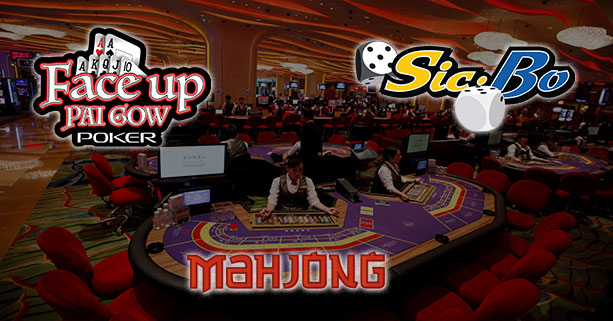Probably no culture in the world enjoys gambling more than Asian cultures. The Chinese, especially, emphasize luck and chance in their cultural identity.
But as a practical matter, what kinds of card games do Asians prefer to play? What other Asian gambling games are out there, and what should you do if they’re the only game in town?
This post lists the most popular Asian card games and looks at some other Chinese gambling games, too.
Baccarat Is the Most Popular Card Game among Asians
You know how when you go to a casino in the United States, and you see lots of blackjack tables? You also see some craps and roulette tables, but mostly, the table game floor is dominated by slot machines and blackjack tables.
You might as well be tossing a coin. Of course, if you placed an even-money bet on a coin toss, you’d be playing a break-even game. That’s NOT the case with baccarat, which has a definite house edge—albeit a lower one than most table games. The banker bet is the best bet in the game, with a house edge of only 1.06%.
Tien Gow Is a Whole Category of Chinese Gambling Games Played with Chinese Dominoes
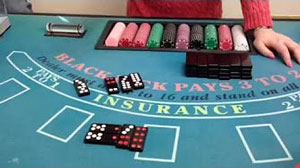
You know how there are multiple poker games, but they’re all recognizable as poker, and they all use a standard American deck of 52 cards? The Chinese equivalent is Tien Gow, which is the name of several Chinese gambling games that use either a pair of dice or 32 dominoes to determine the outcome. These games have 2 suits:
- The military suit
- The civil suit
Heaven is the top rank in the civil suit, while 9 is the top rank in the military suit. Gambling historians think that the suits used in playing cards have their origins in the suits of Tien Gow.
Here’s a complete list of the ranks in the military suit:
- Nines (3-6 or 4-5)
- Eights (3-5 or 2-6)
- Sevens (2-5 or 3-4)
- Sixes (2-4)
- Fives (2-3 or 1-4)
- Final Three (1-2)
And here’s a complete list of the ranks in the civil suit:
- Heaven (6-6)
- Earth (1-1)
- Man (4-4)
- Harmony (1-4)
- Plum Flower (5-5)
- Long Threes (3-3)
- Bench (2-2)
- Tiger’s Head (5-6)
- Red Head Ten (4-6)
- Long Leg Seven (1-6)
- Red Mallet Six (1-5)
It’s probably easy to see how you could use a pair of dice for this or a set of dominoes.
Throwing Heaven and Nine
In fact, the dice game “Throwing Heaven and Nine” is one of the more popular ways to gamble in Tien Gow. Your goal is to get a higher combination than your opponent. The dice have 21 possible total combinations, 11 in on suit and 10 in the other.
If there’s any other combination, the other players get to roll the dice to throw a higher rank of the same suit. They also get to re-roll if they get the wrong suit; their goal is to “follow suit.” Once they get a roll of the same suit, if it’s higher, they win. If it’s lower, they lose. A tie is treated like a push—no one wins, and no one loses.
The players get to keep throwing until one of them beats the banker. When that finally happens, the role of banker rotates to the right. I guess counter-clockwise is the tradition in Chinese gambling games, just as clockwise is the tradition in Western gambling games. If you know anything about craps, the games will surely sound similar, even though the details are significantly different.
Turning Heaven and Nine
A similar game using the Chinese set of 32 dominoes is called Turning Heaven and Nine. It’s a trick-taking game, similar to Spades in American card games.
You score by counting the red pips in each of your taken dominoes. The player with the higher score based on that wins, and he pays the other player the difference. If it sounds like this is an easy game with no skill involved, well, that’s because it is. In fact, the game resembles the children’s game of war that we play in the United States with playing cards.
For a more complicated gambling game using Chinese dominoes, we’ll look at Playing Heaven and Nine.
Playing Heaven and Nine
This is another trick-taking game using Chinese dominoes, but it’s a 4-player game. The banker deals 8 dominoes to each player, and then he leads the 1st trick. He must use a single, double, triple, or quadruple trick. The other players are required to use the same number of dominoes.
If you can’t beat the dealer’s trick, you must discard your dominoes. Whoever wins the trick gets to lead the next trick. And whoever takes the last trick (or multi-trick) gets to be the banker next. If you don’t win any of the 1st 7 tricks, you automatically lose the last trick, even if you have the best dominoes.
For this game, you have 2 new suits for double tricks:
- Mixed
- Supreme
The mixed suit consists of:
- Heaven and a Nine
- Earth and an Eight
- Man and a Seven
- Harmony and a Five
The supreme suit consists of just one pair: Six and Final Three. If you lead the supreme suit, you can’t help but win, because no one can follow suit. But if it’s not led, it can’t win—it’s a discard.
When dealing with triple tricks and quadruple tricks, you only have the following valid combination:
- Heaves and Nines
- Earths and Eights
- Men and Sevens
- Harmonies and Fives.
You also have a special rule about triple tricks. If your triplet has 2 civil and one military tiles, you can only beat it with a trick having the same composition of suits. This is also true of a triplet with 2 military and one civil tiles.
Scoring and playing are both complicated and intricate. I couldn’t explain it in detail in this post because it would take up the entire word count. But some of the rules features include a multiplier that grows as the winning and losing continues throughout the game. You also get bonuses if you can win final tricks in certain ways.
There are variations of Playing Heaven and Nine that can be played using a 52-card deck. Tien Gow games are closely related to Pai Gow games, which I’m covering next.
Pai Gow
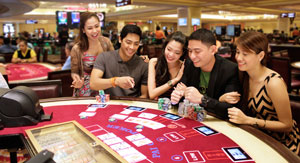
Most Americans are now familiar with Pai Gow Poker, which is an Americanized version of the Chinese dominoes game called Pai Gow. Tien Gow isn’t so much a casino game as Pai Gow is. And both games use a 32-tile deck of dominoes to determine outcomes. I’ll cover the basics of playing Pai Gow here, but it’s a complicated enough game that this probably won’t be sufficient to just sit down and start playing. If you’re really interested in learning how to play Pai Gow, I recommend finding someone who knows how to play and asking them to teach you.
The game starts with the tiles being shuffled on the table. They’re then stacked into 8 piles of 4 dominoes each. This is called “the woodpile.” There are specific, complicated rules for moving stacks and/or tiles to rearrange the woodpile. Once the woodpile is settled, you get to place your bet. You normally play with a dealer and 7 players.
After the bets have been placed, you and the other players—the dealer included—get a stack of tiles. You use these tiles to form 2 hands, each of which contains 2 tiles. The lower-valued hand is your “front hand.” The higher-valued hand is your “rear hand.”
Scoring in pai gow has a typical maximum of 9 points per hand. There are some exceptions based on various complicated rules. If you have 2 dominoes that aren’t a pair, you get the point value by adding the pips on the tile up and dropping the first digit. You can think of this as being similar to baccarat.
Here are a couple of examples:
- You have tiles with a total of 9 pips on them. The score is 9.
- You have tiles with a total of 15 pips on them. The score is 5.
- You have tiles with a total of 20 pips on them. The score is 0.
One way to score more than 9 points with a hand is to get a “Day” or “Teen” tile combined with a tile worth 8. A Day tile is one with a pair of ones on it. A Teen tile is one with a pair of 6s on it. If you combine one of those tiles with an 8, you have a “Gong,” which is worth 10 points instead of 0.
Scoring for pairs is different, too. The higher pair always win, but the rankings are based on an arbitrary ranking rather than point values. They’re ranked, roughly from best to worst, as follows:
- Geen Joon
- Teen
- Days
- Red Eights
- Mismatched Nines
- Mismatched Eights
- Mismatched Sevens
- Mismatched Fives
There are also situations where you and the dealer have the same score. In that case, whoever has the tile worth more wins. For example, if you both have a score of 1, and your highest tile is 7, and the dealer’s highest tile is 10, the dealer wins the tie.
Pai Gow Poker, an Americanized, card-game version of Pai Gow, is becoming increasingly popular with Asian players, too. It’s a good game to play in a casino regardless of your ethnicity, because it’s relatively slow-paced and features lots of pushes. That results in a low volatility game where you don’t lose a lot of money per hour.
Sic Bo
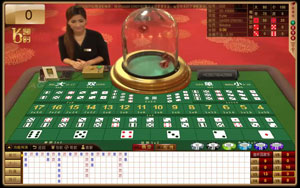
Asian gambling games aren’t restricted to card and dominoes games, either. Sic Bo is a popular dice game, especially in the Philippines. The game uses 3 dice (as opposed to the 2 dice used in craps.) They’re kept in a cage which is turned over, and you can place bets on which totals show up on the 3 dice.There are no rolls and re-rolls in Sic Bo like there are craps. You just roll the dice, and the appropriate bets are paid off, while the rest lose. Sic Bo plays more like roulette than craps, but it’s a fast-action game. When you’re playing roulette, you have to wait for the wheel to stop spinning. In Sic Bo, the dice get flipped, and you have your results instantly.
The problem with Sic Bo is that almost all the bets have a terrible house edge. Even the bests bets in Sic Bo can only be considered average.
Here are some examples of the bets you can make in Sic Bo along with your odds of winning and the payout odds on such a bet:
Small is a bet that the total on the dice will be between 4 and 10. This bet has the same odds and house edge as the “big” bet.
You can also bet on odd or even. These have the same odds and payouts as the other even money bets, and the house edge is the same on these—2.78%.
You can also place bets with longer odds and bigger payouts. You could bet on triples, for example, which is a bet that the same number will appear on all 3 dice. The odds of winning such a bet are 215 to 1, but the payout is only 180 to 1. The house edge is a whopping 16.2% on such a bet.
Some of the most popular bets, too, are bets on various totals. The payouts for such bets, of course, vary based on which total you’ve bet on. A total of 4, for example, is much less likely than a total of 10. So the payout for a bet on a total of 4 is 60 to 1, as contrasted with a payout of 6 to 1 on a bet on a total of 10.
The house edge on those 2 bets is similar though—15.3% versus 12.5%, respectively. Neither is a good bet. There are a wide variety of other bets at the Sic Bo table, but if you stick with the even money bets, you’ll have the house edge as low as you’re possibly going to get it.
Mahjongg
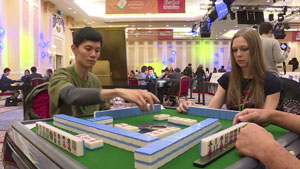
Few gambling games are more popular with Asian gamblers than Mahjongg. Like the Chinese dominoes games already discussed, Mahjongg is played with tiles. It’s normally played with 4 people, and the rules resemble those for the traditional Western card game of rummy.The set of tiles used in Mahjongg has 144 pieces in it. The game starts when each player gets 13 tiles. You get to draw and discard tiles when it’s your turn until you’re able to complete a legal hand using a 14th tile. This legal hand must consist of 4 melds and one eye. (A meld is a set, or 3 of a kind, while an eye is a pair.)
Like other Chinese tile games, there are multiple rules subtleties and exceptions. Some of the rules vary according to the region where you’re playing. Like American card games like poker and rummy, Mahjongg combines skill and chance.
Pachinko and Pachislo
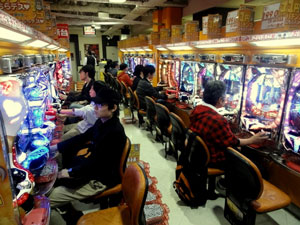
Pachinko is similar to a pinball machine, only it’s completely vertical. There used to be a shop selling pachinko machines near downtown Dallas, but it’s been gone now for years. Pachinko is a Japanese game. When used for gambling, it resembles a slot machine in more ways than one, only the outcomes are determined by a metal ball and where it falls in the machine.Gambling for real money is illegal in Japan, so Pachinko pays out in balls. These balls can be exchanged for prizes but not money.
Pachislo is even more like a slot machine, but it’s also a Japanese gambling game. It consists of 3 spinning reels, but the player gets to decide when each reel stops. This tiny element of skill is what causes many people to define Pachislo as a “skill stop slot machine.”
The most popular Asian gambling games you might encounter include baccarat, Pai Gow, Pai Gow Poker, pachinko, pachislo, and Mahjongg. If you get a chance to try them, you’ll probably enjoy them.

 MENU
MENU